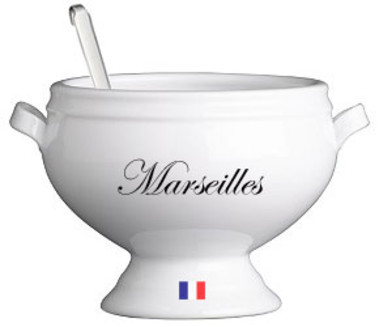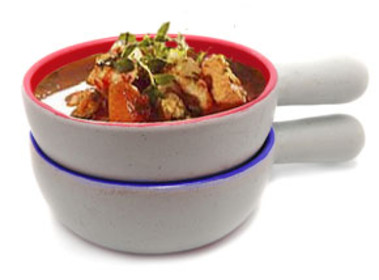Bouillabaisse: O-fish-al branding?
March 5, 2007 - brandchannel.com


Bouillabaisse: O-fish-al branding? Though bouillabaisse is not a brand per se, it’s as tied to Marseilles as Champagne is to the region in which it’s produced and for which it’s named. Unlike the soup, however, the name of the celebratory sparkling wine is legally protected by standards defined by the Appellation d’Origine Contrôlée (AOC). So until the dish is upgraded from lowercase-b bouillabaisse to brand-like, uppercase-B Bouillabaisse, chefs whipping up a high-quality version of the soup will be constantly frustrated—if not threatened—by weaker copies of the product.
The first bouillabaisse of my life, I ate alone and unobserved, a short distance from the Notre-Dame de la Garde church in Marseilles, which people from this port consider to be their spiritual mother.
I tasted a spoonful of the city’s fabled fish soup, thought about it for a moment, then slurped another, and quickly, another. I put a dollop of rouille—a spicy garlic mayonnaise—on a small toast round, submerged it in the broth and ate that, too, launching an attack on my senses.
Somehow, it tasted like time and tradition: something prepared, labored over, and primal. I quickly found myself hunched over, forgetting to savor—or eat like an adult, for that matter—like someone who finds himself alone in the kitchen after dinner, gnawing ravenously on a chicken carcass.
Once considered a fishermen’s staple, bouillabaisse’s gradual (and rather French) shift toward putting the accent on quality and expense may be what has kept it a tradition.
Here, locals laugh at the relatively cheap “bouillabaisse” served by restaurants that cater to tourists around the city’s Old Port.
“It costs 45 euros [nearly US$ 60] for a bowl here”—the going rate for the real thing, give or take 10 euros—“and it’s 15 in the Old Port,” says Alexandre Pinna, who runs Chez Fonfon, one of the city’s bouillabaisse bastions.
“I could do it for 10 euros if I didn’t put much fish in…I’d put more [inexpensive] conger eel in and less [pricey] scorpion fish,” he says, “but it’s not as good.”
Real bouillabaisse has nearly single-handedly carried Marseilles’ culinary reputation—and sometimes, it seems, the reputation and soul of the city itself. Though it’s painful to think that you need to plunk down somewhere in the neighborhood of 50 euros for the real thing, it could be that the soup’s reputation as a luxury item and the idea that there’s a “real” version of it may have been part of its recipe for success.
“There’s only one recipe, and it’s very easy to make,” says Pinna. “You need good fish and lots of it.”
For the few who are still making bouillabaisse at home, just buying lots of fish from the fishermen who sell their goods from the back of their boats in the Old Port can run almost as much as it does in a restaurant. Add the day’s worth of time that it takes to make it, and the price becomes much more reasonable.
But Pinna is unflinching in the necessity to have a prerequisite group of rockfish to make the dish.
“You’ve got to put the right stuff in. [To use other fish] would be like putting beet oil into a Ferarri,” he claims.
“It started out as a way to eat the fish that weren’t sold. Mostly, it was the ugly ones,” he says, describing it much like the way lobster used to be thought of in New England as poor-peoples’ food.
Pinna also explains that, over time, the dish became a favorite of home cooks. “The secret is quantity and quality,” he says. “When Grandma made the Sunday afternoon family meal, she made bouillabaisse. Once you left her house, you were kind of done for the day,” he adds, putting his hand on his stomach as if dinner after Grandma’s would be absolutely unnecessary.
Family bouillabaisse, however, like that once made on fishermen’s boats, is also heading the way of the placoderm (that’s an extinct fish, for you non-paleontologists).
“It’s a convivial dish, but we’re losing it,” says Pinna, and sure enough, as the words float from his mouth, a convenience-seeking grandmother walks into the restaurant and buys a bottle of Fonfon’s fish soup, to go.
“We sell 5,000 bottles a year,” he adds once the woman walks out the door.
“Some people still make it at home, but it takes a long time,” he says. “Most people don’t have the time to spend all day in the kitchen.”
Exaggerating a bit, I ask if he thinks that it will be only restaurants cooking the dish 20 years from now and he nods “Yes” without hesitating.
After speaking with Pinna, I can’t decide how I feel about a tradition becoming the sole property of a small handful of restaurants. Plus, I’m bothered that it seemingly has to be expensive. I keep thinking of what Julia Child said in Mastering the Art of French Cooking:
“You can make as dramatic a production as you want out of a bouillabaisse, but remember that it originated as a simple, Mediterranean fisherman’s soup, made from the day’s catch or its unsalable leftovers…”
Shouldn’t family-filling regional European dishes like bouillabaisse or a French cassoulet or paella from Spain—both direct bouillabaisse cousins—be able to be made inexpensively?
With this list of questions in my head, I head to L’Epuisette—another of the city’s classic bouillabaisse destinations—where Pierre Psaltis, a Marseille native and the food critic for the regional daily La Provence, claims what I’ve heard is nothing more than clever branding.
“Did you go to see Monsieur Pinna and he told you about the humble beginnings of the dish?”
“Yes.”
“And did you talk to his fisherman who told you about how his fishermen ancestors made and ate the soup on their boats?”
“Err… Yes?”
“It’s folklore,” he says, seemingly relishing the idea that he’s trumped me a bit more than I’d prefer. “Historically, bouillabaisse has always been a dish for the rich,” he explains. “History tells you one thing but the myth tells you another.”
He quickly goes through the research he has done to support his argument, ranging from the expense of saffron in the 17th century to the availability of butter (used at the end to give the broth a sheen) to the poorer classes.
“It’s a sad and unhappy truth, but it’s expensive.”
Funny thing is, once he’s finished playing me like a card, and for as proud as he is of his research, he also buys into the folklore.
He brings up regional author Marcel Pagnol’s famous “Marseille Trilogy,” three plays—Marius, Fanny and César—which Psaltis calls “classic tragedies that exaggerate the traits of the Marseillais.”
He speaks of the literary trio like they are family.
“Honorine, Fanny’s mother, makes an amazing bouillabaisse,” he says. “This is what pushes the myth.”
“Plus, the fishermen are at the heart of our city. Thousands of years and nothing has changed.”
Claude Fromion, a fisherman and unpaid legal arbiter for disputes between his seafaring colleagues, offers a more diplomatic approach.
“Bouillabaisse is everywhere. It’s as old as the world,” he says, while selling the last of his catch from his boat in the Old Port.
“[Making bouillabaisse] is a huge amount of work,” he adds. “If there’s a bunch of people, it’s a bunch of work. It takes a day to make.”
Confronted with the idea of a master recipe, he’s not convinced. “Everybody’s got his own way to do it.”
Back at L’Epuisette, journalist Psaltis seems to forget all of the rules when we tuck into some of the restaurant’s bouillabaisse broth.
This time, the primal things happen to him. He takes a spoonful and hunches forward a bit, then licks his fingers, catches himself doing so in a fancy restaurant, and licks them again.
“Why do you love it?” I ask.
He begins a deliciously French gastro-philosophical jag with his own question: “Why do you love your mother?
“Marseilles is a woman. She’s our mother,” he says, not waiting for a response and gesturing in the direction of Notre-Dame de La Garde. “Who better to feed a man than a woman?” He looks down at his soup. “[Bouillabaisse] is not just a woman. She is our mother.”
Coming back down to Earth, he points his spoon at his bowl.
“This soup? This is my city.”
Joe Ray is a Paris-based food and wine writer. He can be reached via http://www.joe-ray.com.